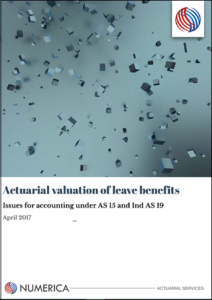
Companies often ask us if an actuarial valuation mandatory for leave schemes. It is clear that accounting and audit professionals require some additional guidance on this matter. In this post, we aim at addressing this issue.
The short answer is, an actuarial valuation will be applicable if your company offers leave benefits that would require an actuarial valuation, as explained in the paragraphs below.
Does your company offer leave benefits?
Most companies offer leave benefits, because it is a statutory requirement by labor laws governed by states.
As per labour laws, companies are required to offer leave benefits, or ‘compensated absences’, every year. Earned leaves and sick leaves are mandatory in most of the state labor laws, however, the minimum number of leaves vary. For instance, the Factories Act and Karnataka Shops & Establishments law requires a minimum of one day for every 20 days worked is to be provided as earned leave. Employers have to provide 12 days per annum sickness leaves as well.
Though the law prescribes the number of days of leaves to be provided to employees, it is silent on how the ‘unused’ leaves must be treated. So companies are free to devise their own rules. For example, they can specify that the unused leaves:
- Can be encashed automatically at the end of the leave year
- Can lapse at the end of the leave year
- Can be carried forward to the next leave year, in entirety, or subject to a limit
So the answer to the question – is an actuarial valuation mandatory for leave schemes – depends entirely on how your company has devised your leave scheme rules. This is explained further below.
By this point, you must have noticed that this is slightly different from the applicability of actuarial valuation on a gratuity plan. The case of gratuity is very straightforward – if you have more than 10 employees, then the Payment of Gratuity Act becomes applicable and you would, most likely require an actuarial valuation. This is further explained here.
Type of leaves schemes
Next, let us first understand the various types of leave schemes. Companies run several types of leave benefit schemes for their employees:
- Privilege leaves (also known as earned or annual leaves),o7
- Sick leaves,
- Casual leaves,
- Maternity leaves,
- Jubilee leave awards etc. may all be available to the employees.
Which leave schemes of the above need actuarial valuation?
There are two types of leave schemes that may require an actuarial valuation:
- Type 1 schemes, where employees have accrued certain leaves during the service rendered till date and unused leaves can be carried forward to future years. Most commonly, these leaves are privilege leaves.
- Type 2 schemes, where employees are entitled to receive a block of leaves upon completing a pre-specified period of service; e.g. jubilee or long-service awards in the form of leaves.
Therefore, leaves that cannot be carried forward (such as most types of sick leaves or non-accumulating privilege leaves) do not require an actuarial valuation.
However, even if an actuarial valuation is not applicable, a provision may still be required in the books of accounts, using other non-actuarial valuation methods. For example:
- Non-accumulating privilege leaves, sick leaves, casual leaves etc, which are still outstanding as at the balance sheet date
- Maternity leaves currently being availed
For these schemes, a liability exists as at the balance sheet date for any leaves that are expected to be taken during the next 12 months. However, you should consider how material this liability is going to be before spending resources on estimating a provision.
Applicability of actuarial valuation under relevant accounting standard
2a. Applicability of actuarial valuation to corporate entities:
According to Chapter IX of Companies’ Act, 2013, every company must prepare books of accounts in accordance with the relevant applicable Accounting Standards as issued by ICAI. One of these accounting standards, AS 15, requires an actuarial valuation to be done for certain types of employee benefits schemes, including the leave schemes discussed above.
Corporate Entities are classified as
- SMCs (Small and Medium Sized Companies) and
- Non-SMCs
The above classification is done according to Companies (Accounting Standards) Rules, 2006. There are few exemptions and relaxations for SMCs in complying with AS 15. To know if you are a SMC, read here.
2b. Applicability of actuarial valuation to non-corporate entities:
Appendix II: Applicability of Accounting Standards to Various Entities, discuss the applicability of accounting standards to non-corporate entities like LLP, Partnerships, Proprietorships, etc.,
Non-corporate entities are classified into 3 categories by ICAI and there are a few relaxations and exemptions in complying AS 15 – Employee Benefits for Level II and Level III Enterprises.
To know if you fall under Level II or Level III Enterprises, read here.
In Summary:
| Corporate Entities | Non-Corporate Entities | ||||
| Non-SMC | SMC | Level I | Level II | Level III | |
| Applicability of AS 15 | Fully | Partly | Fully | Partly | Partly |
Contact Us to learn more on how to make best use of these exemptions and relaxations in complying the accounting standard.
2c. Applicability of Ind AS 19 to companies:
For certain organisations, the Ministry of Corporate Affairs has notified that reporting must be done as per Indian Accounting Standards (Ind AS) framework, as explained below:
- Mandatory:
For the accounting period beginning on or after 1 April 2017, Ind AS 19 is applicable for the following companies:- all listed companies,
- unlisted companies having net worth of Rs.250Cr or more.
- Holding, subsidiary, joint venture or associate companies of the listed and unlisted companies covered above.
- Voluntary:
- Other companies may voluntarily adopt Ind AS for financial statements for accounting periods beginning on or after 1 April 2015
- Please note:
- Once a company starts following the Ind AS 19 mandatorily / voluntarily, it will be required to follow the Ind AS 19 for all the subsequent financial statements even if any of the criteria specified do not subsequently apply to it (the option is irrevocable)
- Once a company starts following Ind AS 19, it will not be required to prepare another set of reports under AS 15
- Please also note, that banks and NBFCs have a different timeline, which you can read more about by clicking on the link in the next line.
- Download our guide for transition to Ind AS 19 by clicking here
Why do these accounting standards need actuarial valuation?
Actuarial valuations are required by AS 15 and Ind AS 19,
- to recognise liability when an employee has provided service in exchange for employee benefits to be paid in future and
- to recognise an expense when the enterprise consumes the economic benefit arising from service provided by an employee in an exchange for employee benefits.
How often do we need actuarial valuation of leave schemes?
1. Financial reporting at year end:
- Actuarial valuations are required at the end of every accounting period for the purpose of preparation of financial statements.
- This is required by all enterprises, if AS 15 or Ind AS 19 is applicable, whether fully or partially.
2. Interim financial reporting:
- Applicable for enterprises which are required to present interim financial results according to AS 25: Interim Financial Reporting
- Provisions in respect of leave schemes for an interim period are calculated on a year-to-date basis
- Uses the actuarially determined rates at the end of the prior financial year, adjusted for significant market fluctuations since that time and for significant curtailments, settlements, or other significant one-time events.
- It implies that actuarial valuation is not mandatory for interim financial reporting.
- However, Ind AS 19 does require an entity to determine the net defined benefit liability or asset with sufficient regularity so that the amounts recognised in the financial statements do not differ materially from the amounts that would be determined at the end of the reporting period.
- In other words, unless the extent of any actuarial gains and losses since the last valuation is expected to be immaterial, a valuation should be performed.
- In a volatile economic environment, it may be necessary for an entity to obtain a valuation at each interim balance sheet date.
Conclusion
- Determine the type of leaves as per your company’s leave scheme. In simple words, leaves that are allowed to be carried forward are the ones that need actuarial valuation (with certain exceptions).
- If Ind AS 19 applies to your company, actuarial valuation is required for both interim and final financial reporting.
- If AS 15 applies to your entity, assess if you are eligible for any exemption or relaxation being in Level II or Level III entities category or being a SMC and avail the same.
Refer to our primary topic page for more information on other topics related to actuarial valuation of employee benefits.
Learn about basics of actuarial valuation of leave schemes by downloading the guide below:
About Numerica
Numerica is a leading provider of actuarial and valuation services to clients in India. We provide full range of actuarial services including actuarial valuation of gratuity, leave and pension plans. We have also introduced a range of other non-traditional actuarial services to Indian companies.


March 16, 2024 at 5:43 pm, N K Das said:
Actuarial valuation